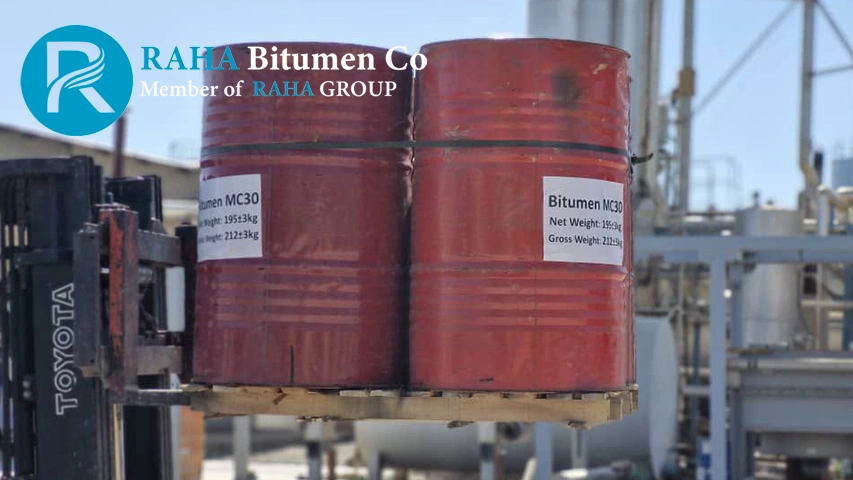
Cutback Bitumen Overview
Cutback Bitumens utilize petroleum solvents to fluidify asphalt cement, dividing them into three types: rapid-curing (RC), medium-curing (MC), and slow-curing (SC) based on solvent fraction evaporation speed.
Rapid curing cutback asphalt cement is a combination of light diluents of high volatility, generally in the gasoline or naphtha boiling point range (RC-70, 250, 800, 3000), and asphalt cement.
Rapid curing cutback asphalt combinations are prepared starting from the lighter diluents, and even from the fluid of higher viscosity. The grades used for rapid curing cutback bitumen are RC-70, RC-250, RC-800 and RC-3000. Here, the value given by numbers 70, 250, 800, and 3,000 represents the kinematic viscosity of the bitumen given in centistokes. The solvent concentration of rapid curing asphalt is 15-45% of the volume of asphalt cement used.
Description
The degree of liquidity developed in each case depends principally on the proportion of solvent to asphalt cement. To a minor degree, the liquidity of the cutback may be affected by the hardness of the base asphalt from which the cutback is made. The degree of fluidity results in several grades of cutback asphalt—some quite fluid at ordinary temperatures and others somewhat more viscous. The more viscous grades may require a small amount of heating to make them fluid enough for construction operations.
Mainly two tests are conducted on cut-back asphalt and are given as 1) residue and 2) cut back test. The testing of residue focusses on examination of penetration, ductility, and solubility. The testing of cutback bitumen includes the distillation, viscosity and flash point tests.
Rapid curing cutback grades are designed to react quickly and are primarily used in spray applications such as bond/tack coats, aggregate chips seals, sand seals, granular priming and similar surface treatments.
Rapid Curing Cutback Bitumen Applications
RC Cutback bitumen are typically used as prime coats and tack coats. Generally Cutback Bitumen are divided into three groups depending on their volatility of the solvent added. The rapid-setting grades are designed to react quickly primarily for spray applications, such as bond/tack coats, aggregate chips seals, sand seals and similar surface treatments.
RC cutback bitumen uses
- When bitumen is applied as a primer to the surface of a road pavement aggregate base course or substrate, cutback agents are used to lower its viscosity. At different concentrations, kerosene is used as a bitumen cutback agent.
- Cutback bitumen is ideal for prime coat and cold application since it is easy to use and doesn’t require thinning or heating.
- RC cutback bitumen consists of the initial addition of asphalt to the surface of non-asphalt based course, prior to any superimposed treatment.
- A cutback asphalt RC is applied to waterproof surfaces, plug capillary voids, and coat and bond loose mineral particles.
Advantages of Rapid Curing Cutback Bitumen
Rapid Curing Cutback Bitumen offers several advantages, making it a popular choice in road construction and maintenance:
- Quick curing time: The most significant advantage is its rapid drying time, allowing for faster project completion.
- Improved workability: Lower viscosity compared to pure bitumen, making it easier to apply and spread.
- Enhanced adhesion: The quick drying process improves the bond between the bitumen and aggregate, resulting in a more durable surface.
- Cost-effective: Faster project completion can lead to reduced labor costs.
- Versatility: Can be used for various applications, including tack coats, surface dressing, and prime coats.
- Suitable for various weather conditions: While it excels in warmer climates, RC can also be used in moderate conditions.
Disadvantages of Rapid Curing Cutback Bitumen
- Environmental Concerns :The use of volatile solvents can lead to the release of harmful volatile organic compounds (VOCs) into the atmosphere, posing environmental and health risks.
- Storage and Handling :Rapid Curing Cutback Bitumen requires careful storage and handling due to the presence of flammable solvents. It must be stored in well-ventilated areas away from sources of ignition.
- Limited Shelf Life :The presence of solvents can affect the shelf life of cutback bitumen, requiring proper storage conditions to maintain its quality.
- Regulatory Restrictions :The use of certain solvents may be restricted or regulated in some regions due to environmental and safety concerns, limiting the use of Rapid Curing Cutback Bitumen in certain areas.
Rapid Curing Cutback Bitumen Safety
- Refer to Safety Data sheets before use.
- Transport, use and store at the lowest temperature possible.
- Eliminate all potential ignition sources during application.
- Avoid breathing vapors. Avoid contact with skin.
- Always wear appropriate PPE including heat protection when used hot.
- DO NOT allow product or washings to enter stormwater or sewer systems.


